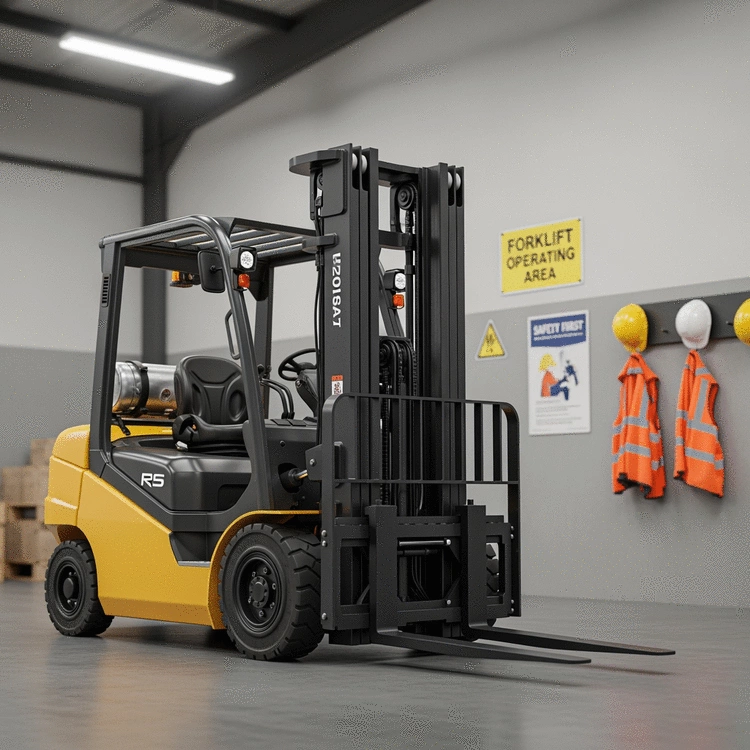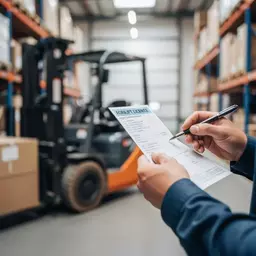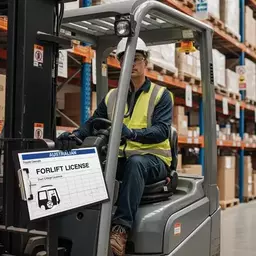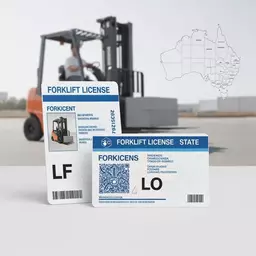As the forklift training industry continues to evolve, understanding the legal landscape surrounding high-risk work licences is more critical than ever. What if I told you that holding a valid forklift licence could be the difference between a safe work environment and a potential disaster? Let's delve into the essential insights you need to ensure compliance and safety in forklift operations.
What You Will Learn
- Importance of High Risk Work Licence: It's mandatory for forklift operators in Australia, ensuring competence and safety.
- Types of Forklift Licences: Understand the differences between LF (forklift) and LO (order picking forklift) licences.
- Role of Licensing Authorities: They set standards, accredit training providers, and enforce compliance for forklift operation.
- Creating a Compliance Program: Regular training, documentation, and safety protocols are essential for workplace safety.
- Continuous Learning: Ongoing assessments and feedback help maintain skill levels and adapt to changing regulations.
- Risk Management Strategies: Regular risk assessments and clear reporting procedures can significantly enhance workplace safety.
Key Aspects of Forklift Licensing in Australia
Understanding Australia's forklift licensing system is essential for operators and employers. This visual highlights the mandatory licence types, their importance, and the critical role of authorities in maintaining safety and compliance.
What is a High Risk Work Licence (HRWL)?
A mandatory licence for operating forklifts, ensuring operators are trained and competent.
- Ensures Safety: Reduces accidents and injuries.
- Legal Requirement: Operating without it is illegal.
- Career Opportunities: Enhances employability.
Different Classes of Forklift Licences
Two primary classes for specific types of forklift operation.
- LF Licence: For standard forklifts (lifting & transporting goods).
- LO Licence: For order picking forklifts (retrieving items from shelves).
Role of Licensing Authorities
They regulate standards and ensure quality training for operators.
- Setting Standards: Competency requirements.
- Accrediting Providers: Ensuring quality training.
- Enforcement: Monitoring compliance & taking action.
Employer Compliance Program
Strategies for managing forklift operator compliance and safety.
- Regular Training: Keep skills and knowledge current.
- Documentation: Meticulous records of training/assessments.
- Risk Management: Identify and control potential hazards.
Understanding High Risk Work Licence Laws for Forklift Operators in Australia
As someone deeply involved in the forklift training industry, I often find that understanding high risk work licence laws is crucial for those looking to operate a forklift legally and safely in Australia. These laws are designed to ensure that operators are educated and skilled, ultimately promoting safety in the workplace. In this section, I'll break down the key aspects of these regulations to help you navigate this important process.
A high risk work licence (HRWL) is not just a piece of paper; it serves as a testament to your competence and commitment to safe forklift operation. This licence is mandatory for individuals who operate forklifts, as it ensures that only qualified personnel handle such powerful machinery. It’s essential to grasp the importance of this licence—not only for compliance but for your own safety and the safety of those around you. For further details on the requirements, you can check out the forklift licence requirements in Australia.
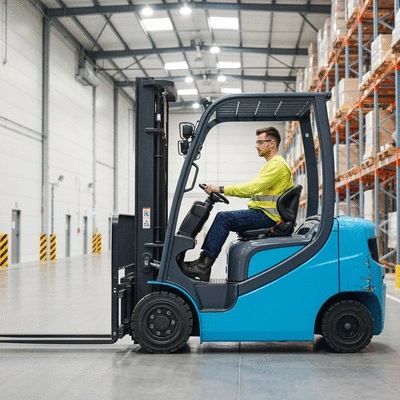
What is a High Risk Work Licence (HRWL) and Why is it Important?
A high risk work licence (HRWL) is required in Australia for various types of high-risk work, including operating forklifts. This licence validates that you have completed the necessary training and assessments to operate a forklift safely. Without it, you could face legal penalties or, worse, be involved in an accident.
- Ensures Safety: The HRWL is vital in promoting safety standards in workplaces, reducing accidents and injuries.
- Legal Requirement: Operating a forklift without the proper licence is illegal and can lead to serious consequences.
- Career Opportunities: Having the licence enhances your employability in industries that rely on forklift operation.
It’s clear that obtaining an HRWL is not merely a formality but a critical step in your forklift journey. The training and knowledge gained through this process prepare you for the responsibilities that come with operating heavy machinery.
Different Classes of Forklift Licences: LF and LO Explained
When it comes to forklift operation, understanding the different classes of licences is key. In Australia, there are two primary classes: LF (forklift) and LO (order picking forklift). Each class allows you to operate specific types of forklifts, and understanding these distinctions can help you choose the right path for your career. To learn more about selecting the appropriate licence, refer to our guide on choosing the right forklift licence.
- LF Licence: This licence allows you to operate standard forklifts used for lifting and transporting goods.
- LO Licence: Specifically designed for order picking forklifts, this licence enables you to operate equipment used in warehouse settings for retrieving items from shelves.
Having the correct licence not only meets legal requirements but also ensures that you are adequately trained for the equipment you will be operating. As someone who is passionate about safety, I encourage you to consider which class aligns with your career goals.
The Role of Licensing Authorities in Forklift Operator Certification
Licensing authorities play a pivotal role in the certification process for forklift operators. They are responsible for regulating the standards and ensuring that training organisations meet the necessary requirements. This oversight is crucial in maintaining safety and compliance across the industry.
- Setting Standards: Licensing authorities establish the competency standards that all forklift operators must meet.
- Accrediting Training Providers: They ensure that registered training organisations (RTOs) are providing quality training and assessments.
- Enforcement: Licensing authorities monitor compliance with regulations and can take action against those operating without proper certification.
By understanding the role of these authorities, you can better appreciate the importance of the training and licensing process. It’s designed not only to protect you as an operator but also your coworkers and the public.
We Want to Hear From You!
What do you think about the importance of obtaining a High Risk Work Licence for forklift operators? Share your thoughts below:
Practical Tips for Employers Managing Forklift Operator Compliance
As employers, our role goes beyond simply ensuring that our forklift operators are licensed. It’s crucial to create a comprehensive compliance program that not only meets legal standards but also promotes a culture of safety and responsibility. By doing this, we protect our employees, our business, and ultimately, our bottom line!
In this section, I will share some practical tips for effectively managing forklift operator compliance. These strategies can help streamline operations and ensure that safety remains a top priority in your workplace.
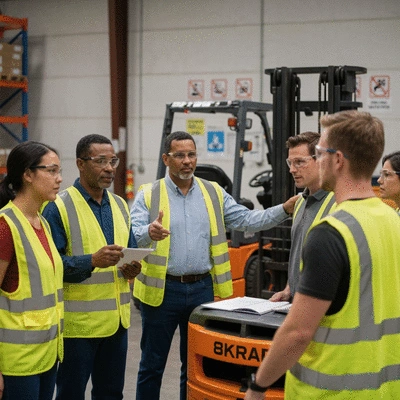
Creating a Comprehensive Compliance Program for Forklift Operations
A well-structured compliance program forms the backbone of any successful forklift operation. Here are some key components to consider:
- Regular Training Sessions: Schedule frequent training for all staff to keep skills sharp and knowledge up-to-date.
- Documentation and Record-Keeping: Maintain meticulous records of training, assessments, and compliance checks.
- Clear Safety Protocols: Develop and communicate clear safety procedures and emergency protocols to all employees.
- Regular Reviews: Conduct periodic reviews of compliance policies and operational practices to identify areas for improvement.
By implementing these components, you create a strong foundation that supports compliance and enhances safety in the workplace. Remember, it's not just about following the law; it's about fostering a safe environment for everyone!
Best Practices for Training and Continuous Learning
Training doesn’t end once a forklift operator obtains their licence. Continuous learning is essential for maintaining safety standards and adapting to new regulations. Here are some best practices:
- Onboarding New Employees: Implement a thorough onboarding process for new hires that includes specific forklift training.
- Ongoing Assessments: Conduct regular assessments and refreshers to ensure operators are maintaining their skills.
- Invite Feedback: Encourage operators to share their experiences and insights during training sessions to foster an open learning environment.
These best practices help create a culture of safety and learning, ensuring that every operator is prepared to handle the challenges of their role.
Developing Risk Management Plans and Hazard Identification Strategies
Managing risks effectively is vital for any forklift operation. By developing comprehensive risk management plans and identifying potential hazards, you can mitigate risks before they become serious issues. Consider these strategies:
- Conduct Regular Risk Assessments: Regularly evaluate the work environment for potential hazards related to forklift operations.
- Establish Reporting Procedures: Create clear procedures for employees to report hazards or unsafe conditions.
- Implement Control Measures: Develop strategies to control identified risks, such as safety barriers or designated walkways.
By proactively identifying and managing risks, you contribute to a safer workplace and enhance compliance with WHS regulations. For more in-depth information on ensuring safety, please check our essential safety practices for forklift operators.
Frequently Asked Questions (FAQs)
What is a High Risk Work Licence (HRWL) and why do I need one for forklifts?
An HRWL is a mandatory licence in Australia for operating machinery considered high-risk, including forklifts. It confirms that an operator has received the necessary training and assessment to operate a forklift safely, thereby reducing accidents, ensuring legal compliance, and enhancing employability.
What are the different types of forklift licences available in Australia?
In Australia, there are two primary forklift licence classes: the LF Licence, which permits the operation of standard forklifts for lifting and transporting goods, and the LO Licence, specifically for order picking forklifts used to retrieve items from shelves in warehouse settings.
What role do licensing authorities play in forklift operator certification?
Licensing authorities are responsible for setting competency standards, accrediting training providers to ensure quality training and assessments, and enforcing compliance with regulations. Their oversight is crucial for maintaining safety and high standards across the industry.
As an employer, how can I ensure my forklift operators are compliant and safe?
Employers should implement a comprehensive compliance program that includes regular training sessions, meticulous documentation of training and assessments, clear safety protocols, and periodic reviews of policies. Continuous learning and effective risk management also play vital roles.
What are some best practices for continuous learning and risk management in forklift operations?
Best practices include thorough onboarding for new hires, ongoing assessments and refreshers for all operators, and encouraging feedback. For risk management, conduct regular risk assessments, establish clear hazard reporting procedures, and implement control measures like safety barriers to mitigate identified risks.
Recap of Key Points
Here is a quick recap of the important points discussed in the article:
- Importance of HRWL: A high risk work licence (HRWL) is crucial for operating forklifts legally and safely, and it significantly promotes workplace safety.
- Classes of Licences: Understand the differences between LF and LO licences to ensure proper qualification for the type of forklift operation.
- Role of Licensing Authorities: They set standards, accredit training providers, and enforce compliance to maintain safety in forklift operations.
- Compliance Program: Employers should create a comprehensive compliance program focusing on training, documentation, safety protocols, and regular reviews.
- Continuous Learning: Ongoing training and assessments are essential for maintaining safety standards and adapting to new regulations.
- Risk Management: Conduct regular risk assessments and establish reporting procedures to proactively manage hazards in the workplace.
